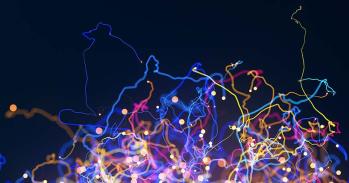Scientists from the University of Cambridge are presenting their research into the nature of antimatter at this year’s Royal Society Summer Exhibition.
Scientists from the University of Cambridge are presenting their research into the nature of antimatter at this year’s Royal Society Summer Exhibition.
Antimatter might sound like science fiction, but it is one of the biggest mysteries in science today.
Val Gibson
Why we live in a universe made of matter, rather than a universe with no matter at all, is one of science’s biggest questions. The behaviour of antimatter, a rare oppositely charged counterpart to normal matter, is thought to be key to understanding why. However, the nature of antimatter is a mystery. Scientists use data from the LHCb and ALPHA experiments at CERN to study antiparticles and antiatoms in order to learn more about it. Some of these scientists, from the University of Cambridge and other UK institutions, will present their work at the Royal Society’s annual Summer Science Exhibition which opens to the public tomorrow (5 July 2016).
At CERN’s Large Hadron Collider particle accelerator, matter and antimatter versions of fundamental particles are produced when the accelerator beams smash into each other. The LHCb experiment records the traces these particles leave behind as they fly outwards from the beam collisions with exquisite precision, enabling scientists to identify the particles and deduce whether they are matter or antimatter. At larger scales, antimatter is studied in CERN’s antiproton decelerator complex, when antiprotons are joined with antielectrons to form anti-hydrogen atoms. The ALPHA experiment holds these antiatoms in suspension so that their structure and behavior can be studied. Both experiments are currently recording data that will enable scientists to carefully build up an understanding of why antimatter appears to behave the way it does.
The University of Cambridge is a founder institute of the LHCb experiment and plays a major part in the construction and operation of the detectors that determine the identity of particles. The detectors use the Ring-Imaging Cherenkov radiation technique via which particles emit radiation as they travel faster than the speed of light in the material of the detectors. The principles behind this technique and the data produced will be on view in the Royal Society Summer Science Exhibition for visitors to examine.
Professor Val Gibson of the University of Cambridge and former UK Spokesperson for the experiment said: “Antimatter might sound like science fiction, but it is one of the biggest mysteries in science today. We’re going to show everyone just why it matters so much – from what it can tell us about the earliest universe, to how we study it at the frontiers of research, to how it has everyday uses in medical imaging.“
Visitors to the Exhibition will also be able to see how fundamental particles and antiparticles are identified with the LHCb experiment, talk to researchers to discover what this science is like, try the experimental techniques used to hold and study anti-atoms with the ALPHA experiment, and move, image and locate antimatter within a PET scanner system.
The Royal Society’s Summer Science Exhibition is weeklong festival of cutting edge science from across the UK, featuring 22 exhibits which give a glimpse into the future of science and tech. Visitors can meet the scientists who are on hand at their exhibits, take part in activities and live demonstrations and attend talks. Entrance is free.

The text in this work is licensed under a Creative Commons Attribution 4.0 International License. For image use please see separate credits above.




